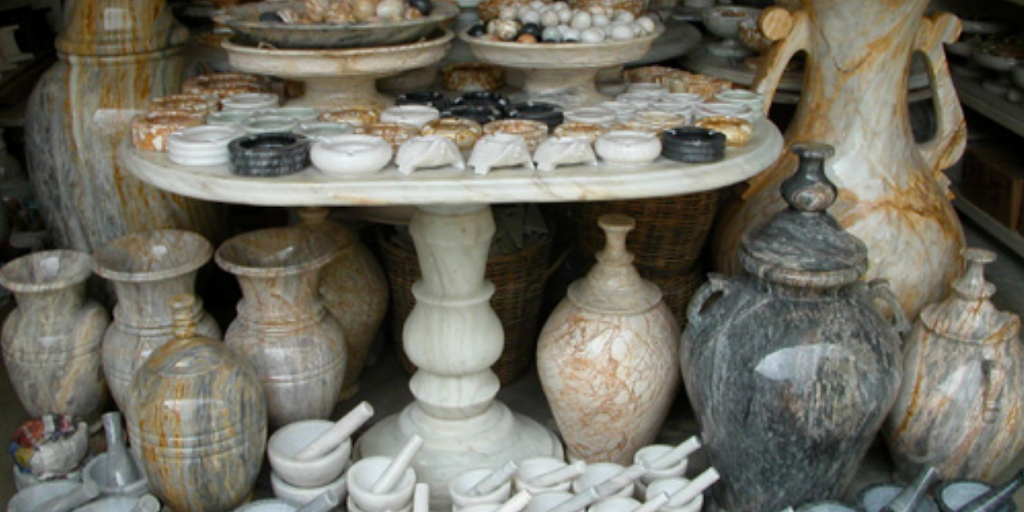Natural Marble Surfaces
One of the oldest materials used for a variety of architectural projects is marble. This natural stone has been the material for everything from floors to statues. Its unmistakable elegance is the highlight of many structures the world over. The beauty of this timeless stone is so appealing to so many that it is used in private homes around the globe. What are the characteristics of natural marble? What is it used for? And, what are the advantages and disadvantages of natural marble? In this post, we will explore the answers to those questions.
Marble’s Composition
This attractive natural material is composed primarily of calcium carbonate in the form of calcite. There are some marbles that have other minerals in them but the primary mineral in the stone is calcium carbonate. It is a metamorphic stone that has been transformed from limestone to its current state through high heat and tremendous pressure. The appearance of natural marble is one that shimmers and glistens because of the calcite (crystallized calcium carbonate). This makes it very shiny when it is polished.
Characteristics
Marble is a natural stone that has very distinct qualities and characteristics. It is a relatively soft stone when compared with other types. It occurs in various shades and ranges in color. However, the purest marbles are completely white. Having fewer mineral contaminates renders the stone white since that is the color of the main mineral calcite.
Uses for Marble
People are surprised to learn that marble is used for so many things. Government buildings, statues, staircases, floors, countertops, and more. This natural stone is rich with historical value and it is easy to see why. Natural marble has an elegant beauty that draws people in. A charming strength that is both delicate and sturdy at the same time.
Marble Building Façades
In the United States a number of government buildings are constructed using marble. One example is the United States Supreme Court Building. Note the following quote taken from Wikipedia on its Supreme Court Building page:
The public façade is made of marble quarried from Vermont, and that of the non-public-facing courtyards, Georgia marble. Most of the interior spaces are lined with Alabama marble, except for the Courtroom itself, which is lined with Spanish ivory vein marble. For the Courtroom’s 24 columns, “Gilbert felt that only the ivory buff and golden marble from the Montarrenti quarries near Siena, Italy” would suffice.
So one use for natural marble is building façades. But there are other uses for marble.
Marble Sculptures
Sculptors use marble a lot as a sculpturing material because it is such a soft stone. Sculptures made from natural marble are in museums and art galleries all over the world.
Marble Countertops
Although marble will need a bit of extra care when used for a countertop, many consumers believe it is worth it. Kitchens are high traffic areas and those that select marble for the kitchen must be mindful of the fact that it needs to be treated delicately and maintained regularly.
A more common place to find a marble countertop is in bathrooms. Bathroom vanities and countertops are a fit for such an elegant stone. Additionally, since there are fewer stain causing liquids there than in a kitchen, the maintenance routine is easier to keep up with.
Cutting Marble
Fabricators work with marble using specific diamond tools designed for cutting soft stone. For example, one diamond tool supplier offers multiple blades that are marketed as marble blades because of the blade’s design. Furthermore, since marble is a soft stone, fabricators find that some blades “clog” up becasue of the waste that gets cut from the material. Having enough water and a blade designed to let the debris clear out contributes to a high performance blade.
Marble’s Benefits
The advantages of marble are primarily in its beauty. Marble is matched in appearance by very few materials. The testimony to this is the fact that engineers are trying to mimic this work of art performed by nature. Yet, they have not been able to reproduce it exactly. It also coordinates with many of the design styles of iterior decorating.
Drawbacks of Marble
The biggest disadvantage of natural marble is the thing that makes it so appealing. The calcite in marble is easily dissolved by acid. This means that any acidic liquid that comes into contact with a marble surface will immediately begin dissolving the stone. This is called etching and it leaves a dull spot on the stone’s surface. Thus, owners of marble do well to be mindful of where in the project marble is used. Additionally, natural marble requires specific cleaners and regular sealing. Applying sealer does not prevent or protect marble from being etched, but gives the owner a bit more time to clean up the eroding liquid before it does too much damage.
Care & Maintenance
There is no substitute for quick reaction times when it comes to a marble surface. Keeping the acid from the stone is the best way to keep etching from happening. Additionally, sealing marble with an impregnating sealer will ehlp to keep colored liquids like olive oil, and salad dressing from getting into the pores and discoloring your marble.
In the end, marble is a timeless natural stone material that is the material for many diverse projects. It is a stone possessing beauty, durability, and luster. It though, like many other materials, has some drawbacks that must be considered when used as a surface material. However, with a bit of forethought and some practical wisdom, having and caring for this extraordinary stone is well worth it for many.


One thought on “Natural Marble”